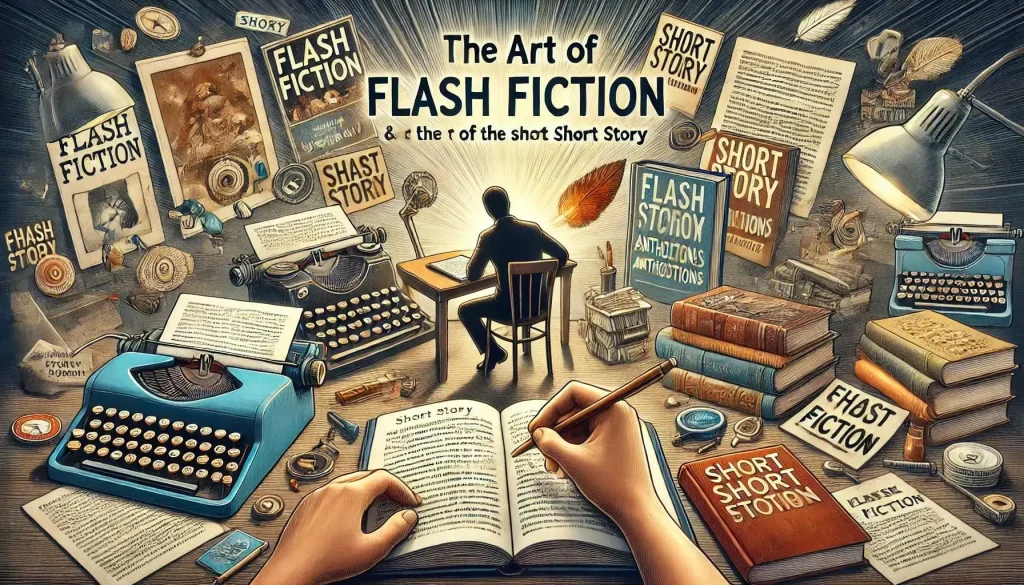Flash Fiction has become a compelling format for storytelling, inviting readers to explore complex themes and characters in a brief, yet impactful, manner. One such notable example is Weike Wang’s **Split Brain**, which deftly intertwines the intricacies of identity and perception using the clever maze metaphor. This story is part of the esteemed **New Yorker Flash Fiction** series, showcasing how tight storytelling can provoke deep literary analysis that resonates long after reading. In just a few hundred words, Wang encapsulates the duality of thought and emotion, presenting a narrative that challenges our understanding of self. As readers dive into this multidimensional maze, they encounter not only the characters’ dilemmas but also a reflection on broader human experiences.
Short-form narratives, often referred to as micro-stories or flash prose, effectively harness the power of succinctness to deliver poignant messages. Weike Wang’s **Split Brain** exemplifies this art, where the juxtaposition of conflicting thoughts is elegantly conveyed through striking imagery and thoughtful dialogues. By utilizing a maze as a symbolic element, Wang invites readers to engage in a rich literary analysis that transcends the constraints of traditional storytelling. This innovative approach echoes the themes prevalent in contemporary flash fiction, where brevity does not compromise depth. As readers navigate the intricacies of character motivations and their backdrop, they unravel a tapestry of meaning that challenges their perspectives on reality.
Exploring the Mind in Weike Wang’s ‘Split Brain’
Weike Wang’s flash fiction piece “Split Brain” delves into the complexities of dual thought processes, represented by the characters Left and Right. This literary analysis reveals how Wang employs a compelling maze metaphor to illustrate the internal conflict between logic and creativity. The characters personify their respective functions: Left embodies reason with its analytical perspective, while Right embraces emotion and imagination. This juxtaposition not only adds depth to the narrative but also invites readers to reflect on their own cognitive dissonances. By highlighting how Left and Right perceive their mother, Wang effectively critiques the human tendency to compartmentalize relationships, which resonates with broader themes of identity and fragmentation in contemporary literature.
The narrative unfolds as an intriguing dialogic structure, showcasing the tension and interplay between different sides of the psyche. Wang’s use of the literary device of the maze signifies the complexity of navigating one’s thoughts and emotions. As Left seeks a singular path towards understanding, Right revels in a diverse, chaotic exploration. The inclusion of fantastical elements—such as the Minotaur and the whimsical creatures lurking in the maze—serves as a powerful literary metaphor for the intricate barriers that obstruct clarity and comprehension in our minds. This allows readers to engage in a richer literary analysis, recognizing how Wang’s characters reflect broader psychological principles.
Flash Fiction: The Art of Brevity in ‘Split Brain’
Flash fiction has become a celebrated genre, showcasing the ability of writers like Weike Wang to convey complex themes in a concise manner. In “Split Brain,” Wang encapsulates profound philosophical inquiries within a few short paragraphs, exemplifying the genre’s capacity to provoke thought while adhering to strict word limits. This efficiency requires authors to distill their narratives to their essential cores, which can often result in a more poignant impact. For readers, this style offers a refreshing approach to storytelling, where each word is intentionally selected to contribute to the overall message, making the reading experience both engaging and enlightening.
Wang’s flash fiction also serves as an exploration of the human psyche through a unique narrative structure. Each character’s distinct voice leads us through a labyrinth of ideas, tackling themes of identity, morality, and familial relationships. The choice to focus on dialogue not only enhances the tension between Left and Right but also highlights the contrast in their worldviews. This storytelling method ensures that even in brevity, the exploration of intricate themes remains rich and layered, reaffirming the power of flash fiction in modern literature. Ultimately, “Split Brain” stands as a testament to how flash fiction can address profound narratives adeptly and meaningfully.
Literary Devices and Metaphors in ‘Split Brain’
In “Split Brain,” Weike Wang employs various literary devices to enrich her narrative, particularly through the maze metaphor that serves to illustrate the convoluted paths of human thought. The maze is not just a physical space but represents the complexities of understanding oneself and one’s relationships. Each potential exit from the maze highlights the diverging perspectives of Left and Right, emphasizing the struggle of reconciling differing views within one’s psyche. This metaphor effectively engages readers, inviting them to navigate their interpretations and reflections on the story’s deeper meanings.
Furthermore, Wang’s sharp use of dialogue emphasizes the distinct voices of Left and Right, allowing readers to engage directly with their conflicting ideologies. These interactions unveil the characters’ duality and the inherent tension in human cognition, making the literary analysis multifaceted. The dynamic between the characters can be seen as a microcosm for broader studies of personality and mental processes, showcasing Wang’s skillful manipulation of language to create a rich tapestry of meaning. This approach not only highlights her mastery of flash fiction but also underlines the relevance of literary devices in conveying complex themes succinctly.
The Role of Mother in ‘Split Brain’
In “Split Brain,” the figure of Mother plays an essential role in the dialogue between Left and Right, serving as both the focal point and the embodiment of familial complexity. As Left and Right grapple with their identity in relation to her, it raises questions about attachment, separation, and the idealization of parental figures. The narrative’s exploration of how their mother is perceived—either as an amalgamation of traits or as a singular entity—reflects the broader philosophical inquiries regarding human relationships and their inherent messiness. Wang’s choice to place Mother at the maze’s center underlines her significance in shaping their psychological framework.
Moreover, the portrayal of Mother as both a revered figure and a subject of analysis illustrates the duality present within many familial relationships. Left’s analytical approach starkly contrasts Right’s more emotional, intangible view of their mother’s role in shaping their identity. This dichotomy compels readers to reflect on their familial dynamics, fostering a connection between the characters’ experiences and the universal themes of maternal influence. Through this layered exploration, Wang manages to portray Mother not simply as a character but as a symbol of the complexities of love, expectation, and psychological development.
Navigating the Maze: Themes in ‘Split Brain’
The themes of navigation and exploration in Wang’s “Split Brain” reflect the broader human experience of grappling with internal conflicts. As Left and Right journey through their metaphorical maze, they not only confront the various challenges posed by their thoughts but also reveal the fundamental struggle to understand one’s self amidst competing desires and fears. This theme of navigation resonates deeply with readers, who may find parallels in their own life experiences. The tension between seeking clarity and embracing the chaos of thought becomes a poignant reminder of the intricate nature of the human psyche.
Additionally, the maze metaphor extends beyond individual cognitive struggles to encompass societal expectations and norms. Left’s desire for a clear, logical path contrasts sharply with Right’s whimsical embrace of uncertainty. This theme underscores the narrative’s exploration of how we often build societal structures around our understanding—seeking to create a coherent narrative out of the chaos. In their quest, Left and Right not only seek to navigate their personal maze but also comment on the broader human condition of striving for meaning in an increasingly complex world.
Power Dynamics in ‘Split Brain’
The power dynamics illustrated in “Split Brain” reflect established patterns within both personal and societal contexts. As Left and Right negotiate their thoughts concerning Mother and the maze, they exhibit varying degrees of control and influence over one another’s perspectives. This tension mirrors broader societal structures where logic often seeks to impose order on creative chaos, reflecting the age-old philosophical debate over reason versus emotion. Wang’s use of these dynamics engages readers in considering how power operates within our personal relationships and community structures.
Furthermore, Wang highlights the potential hazards of a singular narrative. Left’s certainty about how to understand their mother contrasts with Right’s open-ended exploration of possibilities, suggesting that when power is concentrated in one perspective, it can lead to a dangerous oversimplification of reality. The story invites reflection on the importance of balance in understanding—the necessity to incorporate both logical reasoning and emotional depth when navigating complex identities and interpersonal relationships. Through the characters’ journey, Wang skillfully critiques established hierarchies of thought, allowing readers to reflect on their own biases and blind spots.
The Importance of Identity in ‘Split Brain’
Identity plays a pivotal role in Weike Wang’s “Split Brain,” where the characters Left and Right not only represent divergent thought patterns but also exemplify the multifaceted nature of self-conception. Their struggle to define their relationship with their mother reveals the complexities of identity formation, particularly in a familial context. Wang’s exploration of how both sides of the psyche grapple with defining themselves in relation to their mother underscores the often convoluted paths individuals take in understanding who they are.
As the narrative unfolds, the interplay between Left and Right adds additional layers to the notion of identity. Left’s rigorous analysis and Right’s imaginative exploration suggest that identity is not a fixed entity but instead a fluid amalgamation of experiences and perceptions. Wang invites readers to reflect upon their identities and the myriad influences that shape them, ultimately emphasizing the need for a holistic understanding of self. This nuanced portrayal makes “Split Brain” a significant commentary on identity in modern society, encouraging dialogues about mental complexity and personal growth.
Flash Fiction’s Influence on Contemporary Literature
Flash fiction has emerged as a vital genre in contemporary literature, offering authors a unique platform to explore complex themes within a constrained format. Weike Wang’s “Split Brain” exemplifies this trend, blending innovative storytelling with rich thematic exploration. The genre allows for innovative approaches to character development and narrative structures, emphasizing brevity without sacrificing depth. Through just a few hundred words, Wang manages to evoke an intricate emotional landscape, demonstrating how flash fiction can provoke meaningful insights into human psychology.
Moreover, by participating in the New Yorker Flash Fiction series, Wang contributes to a broader conversation about the importance of short narratives in today’s fast-paced world. This genre’s ability to convey profound messages in minimal text resonates with contemporary audiences who seek impactful stories amid overwhelming stimuli. Flash fiction cultivates a space for experimentation and risk-taking among writers, encouraging them to distill their thoughts into powerful, concise explorations. Wang’s work illustrates the enduring relevance of this format, reminding readers that even the briefest tales can unravel the deeper complexities of human existence.
Frequently Asked Questions
What is Flash Fiction and how does it differ from traditional short stories?
Flash Fiction is a brief narrative that typically comprises fewer than 1,000 words, focusing on a singular event or moment. Unlike traditional short stories, Flash Fiction is crafted to deliver a concise yet impactful message, often leaving room for interpretation and emotion. Notable examples can be found in publications like the New Yorker, which features various Flash Fiction pieces.
How does Weike Wang’s ‘Split Brain’ exemplify the characteristics of Flash Fiction?
Weike Wang’s ‘Split Brain’ exemplifies Flash Fiction through its compact narrative structure, vivid imagery, and deep thematic exploration within a limited word count. The story utilizes the maze metaphor to explore complex ideas about identity and duality, showcasing Wang’s skill in creating profound meaning in a brief format.
What role does literary analysis play in understanding Flash Fiction like ‘Split Brain’?
Literary analysis enhances the understanding of Flash Fiction pieces such as ‘Split Brain’. By examining elements like symbolism, character dynamics, and thematic depth, readers can uncover layers of meaning that enrich their interpretation. This type of analysis is particularly relevant for Flash Fiction, where every word counts and intricate details can reveal significant insights.
Why is the maze metaphor significant in Flash Fiction narratives?
The maze metaphor, often employed in Flash Fiction like Wang’s ‘Split Brain’, represents the complexity of human thought and emotion. It illustrates the struggle between different aspects of the self, reflecting the intricate paths and choices we face in life. This adds depth to the narrative, inviting readers to engage with the metaphor on both a literal and figurative level.
How can I find more examples of Flash Fiction similar to Weike Wang’s work?
You can discover more Flash Fiction examples by exploring online literary magazines like the New Yorker, which regularly publishes Flash Fiction pieces. Additionally, anthologies and collections of contemporary Flash Fiction often feature works from various authors, showcasing a range of styles and themes that resonate with Wang’s approach.
| Key Point | Description |
|---|---|
| Split Brain Concept | The story explores the duality of thought represented by the right and left brain. |
| Metaphorical Characters | The Right brain is imaginative and free-spirited, while the Left brain is analytical and rational. |
| The Mother Figure | She represents origin and end, central to their discussions, illustrating emotional and complex ties. |
| Literary Analysis Debate | The narrative delves into conflict between emotional engagement and rational analysis of relationships. |
| Future Governance | Speculation on societal structures arising from their thought processes about power and control. |
| Symbolism of Hedges | Represents boundaries and protection of the central figure, indicating complexity in a relationship. |
Summary
Flash Fiction is a powerful artistic medium that skillfully captures complex narratives in a brief format. In “Split Brain” by Weike Wang, the intricacies of human emotions and thought processes unravel through the lively interaction of the right and left brain. The interplay illustrates the balance of creativity and logic, emphasizing the depth of personal connections and their implications in broader societal contexts.



